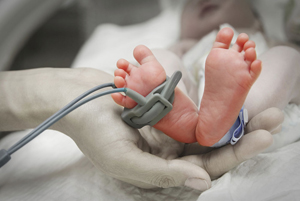
Extreme hot or cold temperatures during pregnancy may increase the risk that infants born at term will be of low birth weight, according to a study of U.S. women by researchers at the National Institutes of Health. The study was published in Environmental Research.
The authors found that exposure to atypically cold temperature during the entire pregnancy, or just during the second trimester and third trimester, increased the risk for low birth weight. Exposure to atypically hot temperatures during the whole pregnancy, or during the third trimester, also increased this risk. The odds for low term birth weight were highest when the whole pregnancy was exposed to extreme temperatures.
“Until we can learn more, it makes sense to reduce the amount of time that pregnant women are exposed to extreme hot or cold weather,” said the study’s senior author, Pauline Mendola, Ph.D., an epidemiologist in the Division of Intramural and Population Health Research at NIH’s Eunice Kennedy Shriver National Institute of Child Health and Human Development (NICHD).
Low birth weight refers to infants weighing less than 5.5 lbs. at birth. Infants may be of low birth weight because they are born prematurely, while others may be of low birth weight even though they have completed the 37-40 weeks that is considered to be a term pregnancy. Some are otherwise healthy, but are genetically predisposed to small size. Others are of low birth weight because of an underlying health problem—illness, infection or a failure to grow in the womb. Compared to infants of normal weight, low birth weight infants may be at higher risk for infection and developmental delays.
In the current study, NICHD researchers linked medical records from 223,375 births at 12 U.S. clinical centers to hourly temperature records for the region surrounding each center. They defined extreme cold as below the 10th percentile of average temperatures for a region; extreme heat was above the 90th percentile.
Infants born at term to mothers exposed to cold during either the second or third trimester were 18 to 21 percent more likely to be of low birth weight. When exposed to extended cold over the entire pregnancy, term infants were 257 percent more likely to be of low birth weight.
Term infants exposed to heat in the third trimester were 31 percent more likely to be of low birth weight, and infants born after the entire pregnancy occurred during atypically hot temperatures were 249 percent more likely to be of low birth weight.
Researchers do not know why exposure to atypically high or low temperatures would affect birth weight. The authors noted that previous studies have suggested that heat exposure could affect birth weight by increasing oxidative stress—toxic byproducts formed when oxygen interacts with cells and tissues—and by increasing inflammation. It is also possible that temperature extremes could reduce blood flow to the uterus, depriving the infant of oxygen and nutrients and hindering the placenta’s ability to remove fetal wastes.
The study adds to the researchers’ 2016 analysis of the same data in which they reported that extreme heat and cold may increase the risk of preterm birth.
###
About the Eunice Kennedy Shriver National Institute of Child Health and Human Development (NICHD): NICHD conducts and supports research in the United States and throughout the world on fetal, infant and child development; maternal, child and family health; reproductive biology and population issues; and medical rehabilitation. For more information, visit NICHD’s website.
About the National Institutes of Health (NIH): NIH, the nation's medical research agency, includes 27 Institutes and Centers and is a component of the U.S. Department of Health and Human Services. NIH is the primary federal agency conducting and supporting basic, clinical, and translational medical research, and is investigating the causes, treatments, and cures for both common and rare diseases. For more information about NIH and its programs, visit http://www.nih.gov.

 BACK TO TOP
BACK TO TOP